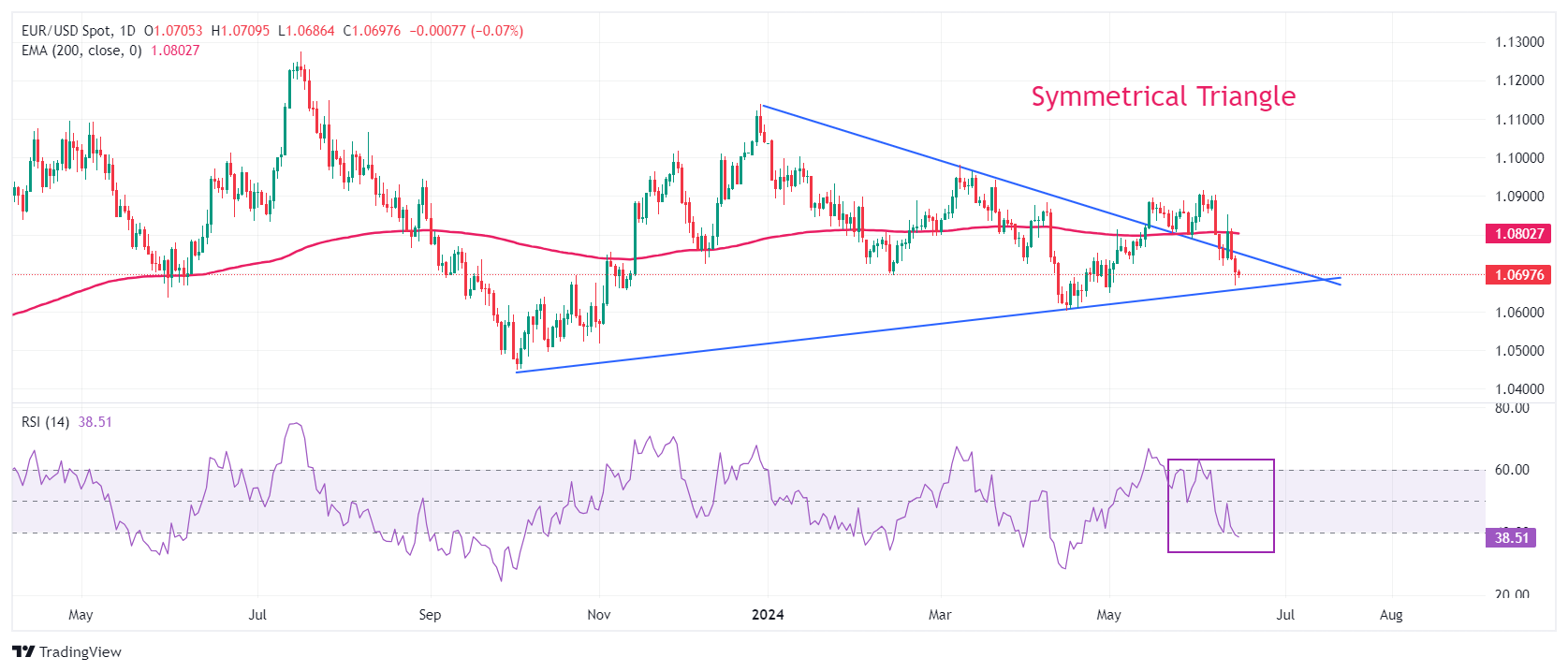EUR/USD consolidates as investors look for fresh cues on Fed’s policy outlook

- EUR/USD trades around 1.0700, and remains on the backfoot amid French elections uncertainty.
- Investors worry the French economy will face a financial crisis if the far right forms a new government.
- The US Dollar will dance to the tunes of the US Retail Sales data.
EUR/USD trades in a tight range near the crucial support of 1.0700 in Monday’s European session. The major currency pair has been under pressure as potential risks of the financial crisis in France amid firm speculation that Marine Le Pen’s far-right National Rally (RN) will form a new government, which will have an adverse impact on the nation’s fiscal situation, that has dampened Euro’s appeal.
French Finance Minister Bruno Le Maire said on Friday that the euro zone’s second-biggest economy was at risk of a financial crisis if either the far right or left won because of their heavy spending plans, Reuters reported.
On the monetary policy front, European Central Bank (ECB) policymakers have been reluctant to provide an interest rate-cut trajectory as they remain concerned over the stubborn wage growth outlook, which could revamp price pressures again.
On Sunday, ECB Governing Council member and Governor of the Bank of Latvia Martins Kazaks said that the bank must not allow inflation to remain above 2% into 2026. Kazaks added, “Currently, I think we are still on the path to 2% in the second half of 2025, and I really hope that we will do it by that time.”
Daily digest market movers: EUR/USD trades back and forth while more downside looks likely
- EUR/USD trades sideways around 1.0700 after discovering interim support near 1.0660 as the US Dollar (USD) struggles to extend upside above a six-week high of 105.80. The US Dollar Index (DXY), which tracks the Greenback’s value against six major currencies, corrects modestly to near 105.50.
- The USD Index grinds between market speculation for two rate cuts by the Federal Reserve (Fed) this year due to resumed progress in the disinflation process and the Fed’s projection for only one rate cut amid fears of reacceleration in price pressures.
- According to the CME FedWatch tool, 30-day Federal Fund Futures pricing data has firm expectations to begin reducing interest rates from the September meeting and following suit again in the November or December meeting.
- After the Fed’s blackout period, policymakers advocate for only one rate cut this year, as they updated in the latest interest rate projections. On Friday, Chicago Fed Bank President Austan Goolsbee said that he was relieved after consumer and producer inflation data for May showed that price pressures were softer than expected. However, he wants to see similar data for months before lowering interest rates.
- Going forward, investors will pay close attention to the United States (US) monthly Retail Sales data for May, which will be published on Tuesday. The Retail Sales data, a close measure of consumer spending, is estimated to have increased by 0.3% after remaining flat in April.
Technical Analysis: EUR/USD sees more downside towards 1.0630
EUR/USD hovers around 1.0700 after returning into the Symmetrical Triangle formation on a daily timeframe. The major currency pair is expected to find support at 1.0636, near the upward-sloping trendline of the chart pattern plotted from the low from October 3, 2023, at 1.0448, and the horizontal cushion plotted from the April 16 low around 1.0600.
On the upside, the downward-sloping border from the high of December 28, 2023, at 1.1140 will be a major barrier for the Euro bulls near 1.0750.
The long-term outlook of the shared currency pair has also turned negative as prices dropped below the 200-day Exponential Moving Average (EMA), which trades around 1.0800.
The 14-period Relative Strength Index (RSI) falls below 40.00. Momentum could turn bearish if the RSI sustains below this level.
Economic Indicator
Retail Sales (MoM)
The Retail Sales data, released by the US Census Bureau on a monthly basis, measures the value in total receipts of retail and food stores in the United States. Monthly percent changes reflect the rate of changes in such sales. A stratified random sampling method is used to select approximately 4,800 retail and food services firms whose sales are then weighted and benchmarked to represent the complete universe of over three million retail and food services firms across the country. The data is adjusted for seasonal variations as well as holiday and trading-day differences, but not for price changes. Retail Sales data is widely followed as an indicator of consumer spending, which is a major driver of the US economy. Generally, a high reading is seen as bullish for the US Dollar (USD), while a low reading is seen as bearish.
Next release: Tue Jun 18, 2024 12:30
Frequency: Monthly
Consensus: 0.2%
Previous: 0%
Source: US Census Bureau
